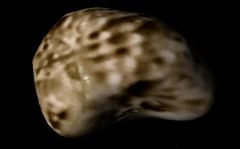Difference between revisions of "Adrastea"
Jump to navigation
Jump to search
(Created page.) |
(Added category.) |
||
| (5 intermediate revisions by 2 users not shown) | |||
| Line 1: | Line 1: | ||
| − | '''Adrastea''' is the second known | + | {{Nsat-Stub}} |
| − | + | ||
| − | Adrastea | + | {| cellpadding="2" cellspacing="0" style="margin:25px 0 0 10px; border:3px solid lightsteelblue;width:250px; font-size:90%; font-family:'Arial','Helvetica'; float: right; clear: right;"Template in Orbiter" |
| + | !bgcolor="lightsteelblue" colspan="2" align="center" |Adrastea | ||
| + | |- | ||
| + | |colspan="2" align="center"|[[Image:Adrastea-jupiteriizip.jpg|240px]] | ||
| + | |- | ||
| + | |colspan="2" align="center"|'''Adrastea from ''jupiter_ii.zip'' in Orbiter 2002''' | ||
| + | |- | ||
| + | !bgcolor="lightsteelblue" colspan="2"|Designation | ||
| + | |- | ||
| + | |Name||align="right"|Adrastea | ||
| + | |- | ||
| + | |width="30%"|Reference body||align="right" width="30%"|[[Jupiter]] | ||
| + | |- | ||
| + | !bgcolor="lightsteelblue" colspan="2"|Planetary mean orbits | ||
| + | |- | ||
| + | |width="30%"|Epoch||align="right" width="50%"|1976.606435 | ||
| + | |- | ||
| + | |width="30%"|Semimajor axis (a)||align="right" width="50%"|129100000 m | ||
| + | |- | ||
| + | |width="30%"|Eccentricity (e)||align="right" width="30%"|0.0018 | ||
| + | |- | ||
| + | |width="30%"|Inclination (i)||align="right" width="30%"|0.054° <br> (0.000942478 radian) | ||
| + | |- | ||
| + | |width="30%"|Longitude of the ascending node (LAN, ☊)||align="right" width="30%"|112.3° <br> (1.96001 radian) | ||
| + | |- | ||
| + | |width="30%"|Longitude of periapsis (ϖ)||align="right" width="30%"|66.41726761° <br> (1.1592 radian) | ||
| + | |- | ||
| + | |width="30%"|Mean longitude (L)||align="right" width="30%"|131.9980168° <br> (2.3038 radian) | ||
| + | |- | ||
| + | !bgcolor="lightsteelblue" colspan="2"|Selected physical parameters | ||
| + | |- | ||
| + | |width="30%"|Mean radius||align="right" width="30%"|12500 m | ||
| + | |- | ||
| + | |width="30%"|Mass||align="right" width="30%"|1.91×10<sup>16</sup> kg | ||
| + | |- | ||
| + | !bgcolor="lightsteelblue" colspan="2"|Rotation elements | ||
| + | |- | ||
| + | |width="30%"|SidRotPeriod||align="right" width="30%"|25747.2 seconds (7.152 hours) | ||
| + | |- | ||
| + | |width="30%"|SidRotOffset||align="right" width="30%"|0 | ||
| + | |- | ||
| + | |width="30%"|Obliqutiy||align="right" width="30%"|0 | ||
| + | |- | ||
| + | |width="30%"|LAN||align="right" width="30%"|0 | ||
| + | |- | ||
| + | |width="30%"|Note||align="right" width="30%"|*Elements given are from Adrastea.cfg (jupiter_ii.zip) | ||
| + | |} | ||
| + | '''Adrastea (Jupiter XV, S/1979 J 1)''' is the second known [[Natural satellites|moon]] by distance and the smallest of the four of the inner moons of [[Jupiter]]. It was the first moon ever discovered by an interplanetary spacecraft, discovered during the 1979 flyby of Jupiter by [[w:Voyager 2|Voyager 2]]. Adrastea was the foster mother of the Greek god [[w:Zeus|Zeus]]. | ||
| + | |||
| + | == Adreastea in Orbiter == | ||
| + | Adreastea was introduced to Orbiter with the release of ''jupiter-ii.zip'' in October 2002. | ||
| + | {|class="wikitable sortable” style="text-align: center" | ||
| + | |colspan="8"|<center>'''Orbiter versions and add-ons which include Adrastea'''</center> | ||
| + | |- | ||
| + | !Add-on!!Source!!Version!!Author!!Type!!Release Date!!Compatibility!!Wiki article | ||
| + | |- | ||
| + | |[https://library.avsim.net/esearch.php?DLID=&Name=&FileName=jupiter_ii.zip&Author=&CatID=root Jupiter II]||AVSIM||||Rolf Keibel||Scenery||26 October 2002|||| | ||
| + | |} | ||
| + | |||
| + | == See also == | ||
| + | [[w:Adrastea (moon)|Adrastea]] at [[w:Wikipedia|Wikipedia]] | ||
| − | + | == Gallery == | |
| − | + | <gallery> | |
| − | + | Adrastea-jupiteriizip.jpg|<center>Adrastea from ''jupiter_ii.zip'' in Orbiter 2002</center> | |
| − | + | Adrastea.jpg|<center>Adrastea as seen by the [[w:Galileo (spacecraft)|Galileo]] spacecraft</center> | |
| − | + | </gallery> | |
| − | |||
| − | |||
| − | |||
| − | |||
| − | |||
| − | [[ | ||
| − | |||
| − | |||
| − | |||
| − | |||
| − | |||
| − | |||
| − | |||
| − | |||
| − | |||
| − | |||
| − | |||
{{JupiterSat}} | {{JupiterSat}} | ||
| − | {{ | + | {{SolarSystem}} |
| + | |||
| + | [[Category:Articles]] | ||
| + | [[Category:Celestial bodies]] | ||
| + | [[Category:Solar System]] | ||
| + | [[Category:Natural satellites]] | ||
| + | [[Category:Satellites of Jupiter]] | ||
Latest revision as of 03:15, 12 September 2024
 | This natural satellite related article is a stub. You can help Orbiterwiki by expanding it.
Adrastea (Jupiter XV, S/1979 J 1) is the second known moon by distance and the smallest of the four of the inner moons of Jupiter. It was the first moon ever discovered by an interplanetary spacecraft, discovered during the 1979 flyby of Jupiter by Voyager 2. Adrastea was the foster mother of the Greek god Zeus. Adreastea in Orbiter[edit]Adreastea was introduced to Orbiter with the release of jupiter-ii.zip in October 2002.
See also[edit]Gallery[edit]
| ||||||||||||||||||||||||||||||||||||||||||||||||||||||||||||||||||||||||||||||||


